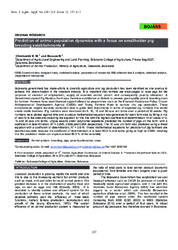| dc.description.abstract | Botswana government has made efforts to diversify agriculture and pig production has been identified as one avenue to achieve this diversification in the livestock industry. It is important that farmers are encouraged to raise pigs for the purposes of creation of employment, supply of essential animal protein and consequently poverty alleviation. A Government owned Pig Nucleus Farm was therefore established at Sebele to provide good quality parent breeding stock for farmers. Farmers have used financial support offered by programmes such as the Financial Assistance Policy, Citizen Entrepreneurial Development Agency (CEDA) and Young Farmers Fund to venture into pig production. These entrepreneurs require accurate production data to guide their investments in terms of expected pig numbers that would create viable business. Pig numbers were monitored for 5, 10, 15 and 30 sow unit farms over a period of 30 weeks. Pig numbers were plotted against time and a unique mathematical equation was generated for each farm size by fitting a line of best fit in the data and selecting the equation for the line with the highest coefficient of determination. In all cases of 5, 15 and 30 sow unit farms, unique second order polynomial equations predicted the number of pigs on the farm with a coefficient of determination, R2 = 0.805, 0.958 and 0.964 respectively. The 10 sow unit farm was predicted using a linear equation with a coefficient of determination, R2 = 0.916. These mathematical equations for prediction of pig numbers are deemed accurate because the coefficient of determination is at least 80.5 % and some going as high as 0.964, meaning that the prediction model can explain at least 80.5 % of the variability. | en_US |

